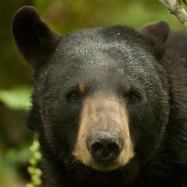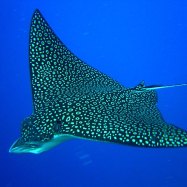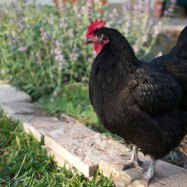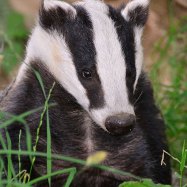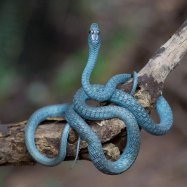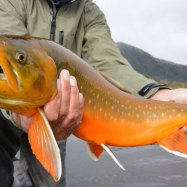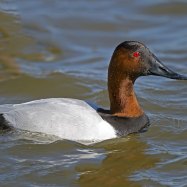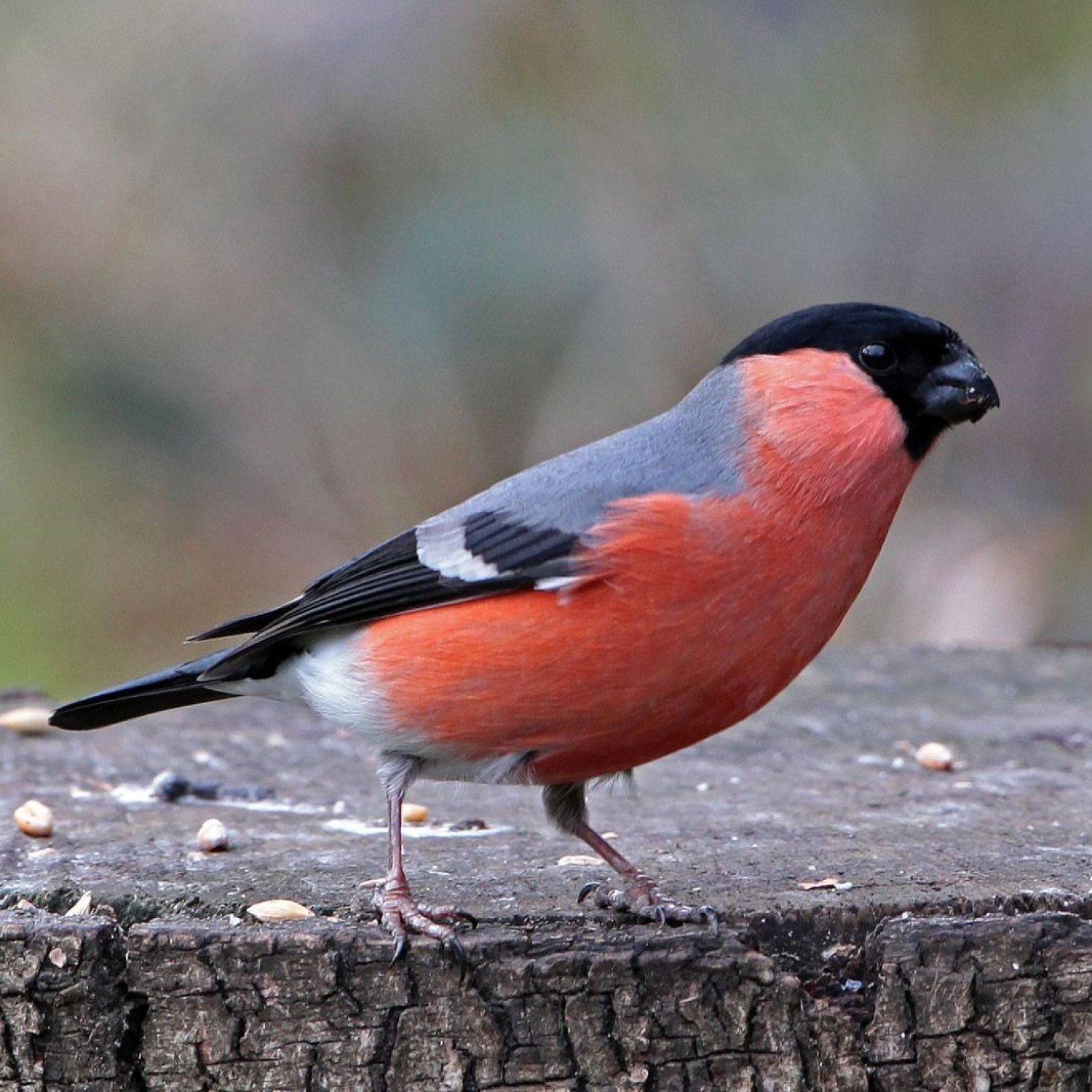
Eurasian Bullfinch
13.5 - 15 cm
The Eurasian Bullfinch is a small yet plump bird found in Eurasia. With a length of 13.5-15 cm, it belongs to the Fringillidae family. Its striking red breast and black head make it a popular bird for birdwatchers. Keep an eye out for this beautiful species on your next trip to Eurasia!
Animal Details Summary:
Common Name: Eurasian Bullfinch
Kingdom: Animalia
Habitat: Woodlands, forests, gardens
The Delightful Eurasian Bullfinch: The Charming Bird of Eurasia
The Eurasian Bullfinch, also known as the Pyrrhula pyrrhula, is a vibrant and enchanting bird native to Eurasia. Its common name is inspired by its striking coloration, while its scientific name derives from the Greek words "pyrrhos," meaning flame-colored, and "pyrrhula," meaning bullfinch.This charming bird belongs to the Kingdom Animalia, the Phylum Chordata, and the Class Aves. It is a member of the Order Passeriformes, which encompasses over half of all bird species, and is part of the Fringillidae family, commonly known as finches Eurasian Bullfinch. The Eurasian Bullfinch can be found in various habitats, including woodlands, forests, and gardens, across Europe and Asia, making it a familiar sight for many bird lovers.
The striking appearance of the Eurasian Bullfinch has made it a popular subject for birdwatchers and artists alike. Let's take an in-depth look at this delightful bird and discover what makes it stand out from other finches.
A Colorful Beauty
One of the most distinctive features of the Eurasian Bullfinch is its vivid coloration, especially in the male birds. The male has a lovely reddish-pink breast and cheeks, a gray back, and a black cap, making it a truly eye-catching sight. The bold contrast of colors on its head and body is enhanced by the black and white markings on its wings and tail feathers.On the other hand, female Eurasian Bullfinches have a more understated coloration. They have a grayish-brown overall plumage, with hints of pink on their chest and belly, and a gray cap. The female's coloring allows it to blend in with its surroundings, making it less conspicuous to potential predators Eastern Hognose Snake.
The Eurasian Bullfinch's coloration is vital for survival, as it helps with mating and camouflage. The bright coloration of the male is attractive to female birds, and it also serves as a warning to other male birds to stay away from its territory. Additionally, the duller coloration of the female allows her to hide from predators while incubating her eggs.
Size and Shape
The Eurasian Bullfinch is a small and plump bird, with a round body and a short tail. It measures between 13.5 to 15 centimeters, making it slightly larger than a house sparrow. Despite its small size, this bird has a significant presence, thanks to its bold coloring and robust body shape.Its short, conical beak is specifically designed for cracking open the seeds of various plants, its primary source of food. It also has sturdy feet with sharp claws, which allow it to cling to branches and peck for food. The Eurasian Bullfinch's body is well-suited for its seed-eating diet and arboreal lifestyle.
Exploring Its Habitat
The Eurasian Bullfinch is a versatile bird that can be found in a variety of habitats across Eurasia, from woodlands and forests to gardens and parks. It is most commonly seen in areas with dense vegetation, where it can find an abundance of seeds and insects to eat.In the summertime, the Eurasian Bullfinch tends to stay in higher altitudes in mountainous areas. However, during colder months, it is known to descend to lower altitudes and can be found near human settlements, where food is more readily available. This bird also tends to remain in the same territory year-round, unlike many other migratory birds.
Food of Choice
The Eurasian Bullfinch is a seed-eater, and its diet mainly consists of various seeds, buds, and fruits. It is particularly fond of the seeds of plants such as birch, alder, and willow trees. In winter, when food is scarce, it will also eat the seeds of garden plants, like ivy and rose hips.These birds are known for their meticulous foraging technique. They use their beaks to crack open seeds, carefully plucking the husks off before eating the nutritious part inside. Insects also make up a small portion of their diet, especially during breeding season, when they need extra protein.
From Europe to Asia
The Eurasian Bullfinch is found throughout Europe and Asia, from the United Kingdom to China and Japan. It is one of the few bird species that can be found in such a vast geographical range, spanning over 6,000 miles.In Europe, the Eurasian Bullfinch is widespread, and it is considered a resident bird in many countries, including the United Kingdom, France, and Germany. It is also found in parts of Northern Africa, such as Morocco and Algeria, and as far east as China and Japan. In some areas, this bird is classified as endangered, largely due to habitat loss and hunting.
A Favorite Among Bird Lovers
The Eurasian Bullfinch is a frequent guest in bird feeders and brings joy to many birdwatchers with its vibrant color and singing voice. Its call is a soft, flutelike song, typically heard in the early morning and late evening. The bird's melodic sound is also accompanied by its bobbing head movements, further adding to its charm.Many people have taken to attracting these lovely birds to their gardens by hanging feeders filled with seeds and nuts. Not only does this allow for a closer look at these feathered wonders, but it also provides them with a source of food during harsh winter months.
A Common Symbol in Folklore and Art
The Eurasian Bullfinch has been revered and celebrated in many different cultures and is a common motif in mythology, folklore, and art. In ancient Greek mythology, the bullfinch was associated with the god Apollo and was believed to possess melodious tunes, much like ancient poets.In Slavic folklore, the bullfinch is a symbol of beauty, love, and fertility. In some traditions, it is believed that a sighting of a bullfinch can bring good luck and prosperity. This bird has also been depicted in literature, paintings, and sculptures, showcasing its iconic status in various cultures.
The Future of the Eurasian Bullfinch
Like many bird species, the Eurasian Bullfinch faces several threats to its survival, primarily due to human activities. Habitat loss and fragmentation, pesticide use, and climate change continue to impact this beautiful bird's population.Fortunately, conservation efforts are being made to protect this species. Several organizations work to preserve the Eurasian Bullfinch's habitat in key areas, and education programs are implemented to raise awareness about its significance to the ecosystem. Additionally, stricter laws and regulations against hunting and trading are being enforced in many countries, ensuring the future of this striking bird.
In Conclusion
The Eurasian Bullfinch is a magnificent and captivating bird that has captured the hearts of many with its enchanting plumage, melodic songs, and endearing personality. Its presence in the woodlands and gardens of Eurasia brings joy and beauty to nature lovers, birdwatchers, and artists alike. This charming bird reminds us of the interconnectedness of all living beings, and the importance of preserving our natural world for generations to come.From its striking coloration and robust body to its foraging techniques and migratory patterns, the Eurasian Bullfinch is a fascinating creature that continues to captivate and inspire us. Its fate is in our hands, and it is our responsibility to ensure that future generations can also delight in the presence of this delightful bird. Let us work together to protect and preserve the Eurasian Bullfinch and all the precious flora and fauna that share our planet.

Eurasian Bullfinch
Animal Details Eurasian Bullfinch - Scientific Name: Pyrrhula pyrrhula
- Category: Animals E
- Scientific Name: Pyrrhula pyrrhula
- Common Name: Eurasian Bullfinch
- Kingdom: Animalia
- Phylum: Chordata
- Class: Aves
- Order: Passeriformes
- Family: Fringillidae
- Habitat: Woodlands, forests, gardens
- Feeding Method: Seed eater
- Geographical Distribution: Europe, Asia
- Country of Origin: Multiple countries in Europe and Asia
- Location: Eurasia
- Animal Coloration: Male: Reddish-pink breast and cheeks, gray back, black cap. Female: Grayish-brown overall.
- Body Shape: Small and plump
- Length: 13.5 - 15 cm
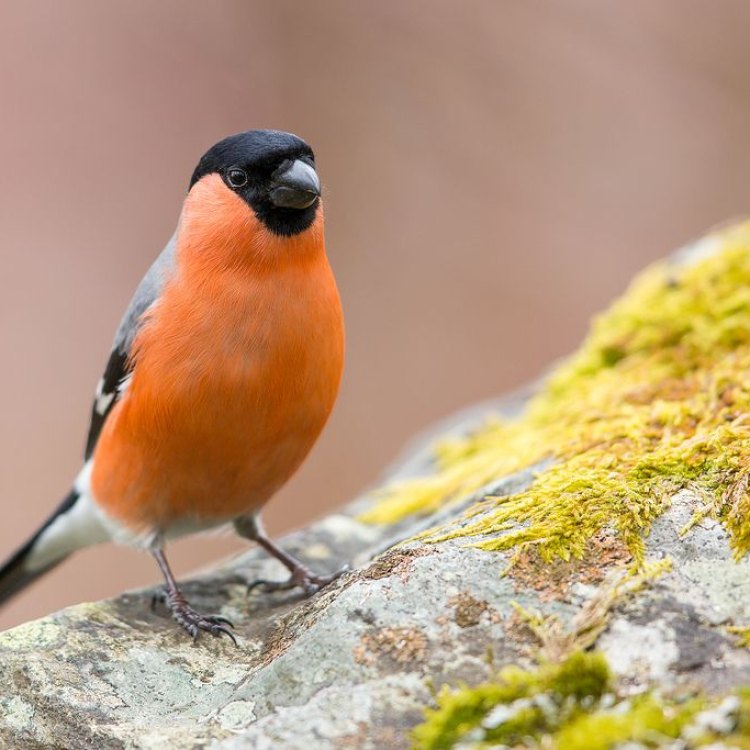
Eurasian Bullfinch
- Adult Size: Small
- Average Lifespan: 2 - 3 years
- Reproduction: Monogamous
- Reproductive Behavior: Breeding pairs build cup-shaped nests
- Sound or Call: Melodious and varied songs
- Migration Pattern: Mostly sedentary, some migrations in winter
- Social Groups: Pairs or small family groups
- Behavior: Shy and secretive
- Threats: Habitat loss, pesticide use, illegal trapping
- Conservation Status: Least Concern
- Impact on Ecosystem: Seed dispersal
- Human Use: Birdwatching, pet trade
- Distinctive Features: Male's vivid reddish-pink breast and cheeks
- Interesting Facts: In some cultures, the Eurasian Bullfinch is associated with folklore and Christmas traditions.
- Predator: Predation by birds of prey
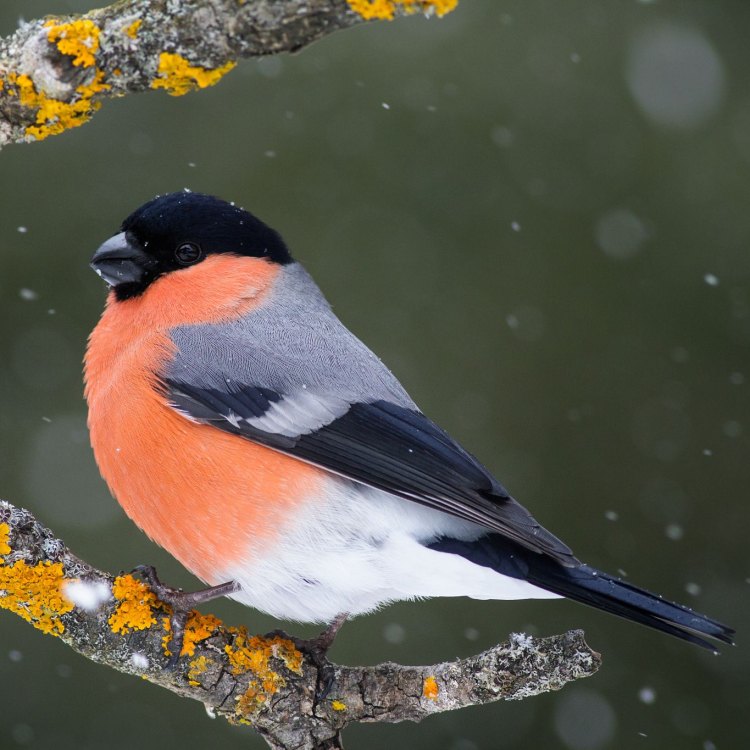
Pyrrhula pyrrhula
The Beautiful and Elusive Eurasian Bullfinch: A Mysterious Songbird
With its vivid reddish-pink breast and shy demeanor, the Eurasian Bullfinch is a stunning and elusive bird that captivates birdwatchers and nature enthusiasts alike. This small-sized songbird may seem ordinary at first glance, but it holds many unique features and secrets waiting to be discovered. From its monogamous reproductive behavior to its role in seed dispersal, the Eurasian Bullfinch is a fascinating creature that deserves our attention and protection.Adult Eurasian Bullfinches are small birds, measuring only 16 centimeters in length and weighing about 22 grams PeaceOfAnimals.Com. They have a distinctive appearance, with the males boasting a vivid reddish-pink breast and cheeks, while the females have a more subtle pink and gray coloring. Their beaks are short and cone-shaped, perfect for cracking open seeds and fruits, their preferred diet. These birds have an average lifespan of 2-3 years, with some individuals living up to 6 years in the wild.
These secretive birds are mostly sedentary, meaning they do not migrate long distances. However, some populations in northern Europe do migrate during winter to find better food sources. In their breeding grounds, the Eurasian Bullfinches live in pairs or small family groups, and they are monogamous, meaning they mate for life. In the spring, breeding pairs will build cup-shaped nests made of twigs and grass, hidden in tree branches or bushes to protect their young from predators.
One of the most intriguing aspects of the Eurasian Bullfinch is their reproductive behavior. These birds are known for their monogamous nature and strong pair bonds Eland. They are believed to mate for life and will often stay together even outside of the breeding season. While they may seem unremarkable in appearance, these birds have a melodious and varied song that they use to communicate with their mates and defend their territory. However, they are generally shy and secretive, making it challenging to spot or observe them in the wild.
Unfortunately, the Eurasian Bullfinch is facing several threats to its survival. Habitat loss due to deforestation and agriculture is one of the major concerns, as these birds rely on trees and shrubs for nesting and foraging. Pesticide use also poses a significant threat as it can poison their food sources and even directly harm the birds. Additionally, illegal trapping for the pet trade is also a problem, as some people find their colorful appearance desirable. These threats have led to a decline in some populations, although the species, as a whole, is considered to be of least concern.
Aside from being a critically important species to the ecosystem, the Eurasian Bullfinch also has a significant impact on seed dispersal. Their diet consists primarily of seeds and fruits, and as they forage, they inadvertently collect and disperse seeds to new areas, aiding in plant growth and regeneration. In this way, these birds play a vital role in maintaining the balance and diversity of plant life in their habitats.
The Eurasian Bullfinch also holds a special place in human culture and traditions. In some European cultures, this bird is associated with folklore and Christmas traditions. In Finland, the Eurasian Bullfinch is considered a symbol of good luck and is often featured in festive decorations and cards. In some parts of Europe, it is believed that seeing a Eurasian Bullfinch is a sign of happiness and good fortune to come.
However, this bird is not immune to predators. As with most small birds, the Eurasian Bullfinch is vulnerable to predation by birds of prey, such as hawks, falcons, and owls. They have developed several defense mechanisms to avoid being caught, including staying close to shelter and quickly flying away at the slightest hint of danger.
But despite the challenges and threats that the Eurasian Bullfinch faces, there are still ways that humans can positively interact with these captivating birds. Birdwatching is a popular activity among nature enthusiasts, and the Eurasian Bullfinch is one of the most sought-after sightings. Observing these birds in their natural habitat, listening to their songs and watching their behaviors, can be a rewarding and memorable experience.
However, it is crucial for birdwatchers and other visitors to respect their habitats and avoid any actions that may disturb or harm these birds. Sustainable tourism practices and responsible wildlife viewing can help ensure the protection and conservation of the Eurasian Bullfinch, and other vulnerable species, for generations to come.
In conclusion, the Eurasian Bullfinch is a mysterious and stunning songbird with many unique and admirable qualities. From its monogamous reproductive behavior to its role in seed dispersal, these birds play a vital role in their ecosystems and human culture. It is our responsibility to ensure their survival by protecting their habitats and reducing the threats they face. The Eurasian Bullfinch may be small in size, but it holds a significant place in the natural world and in our hearts.
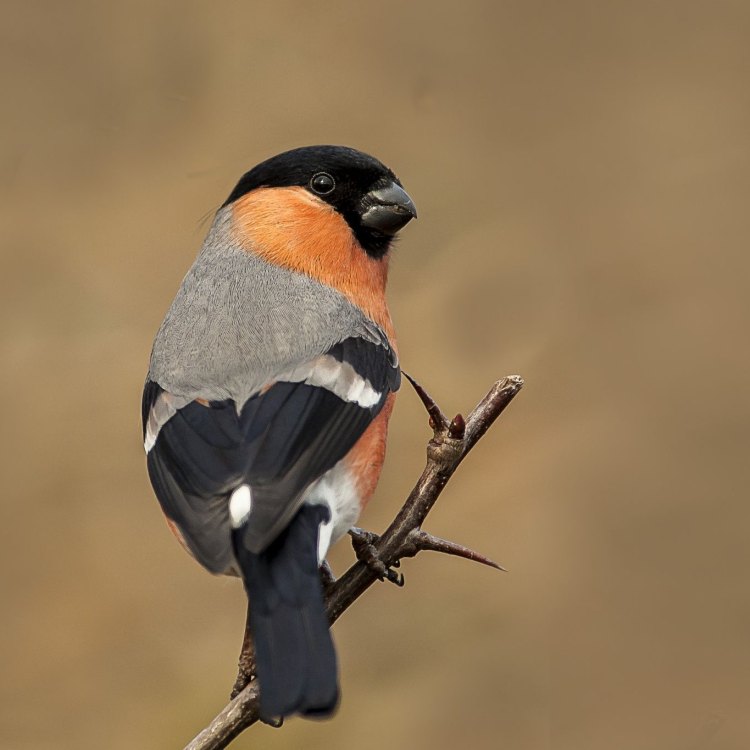
The Delightful Eurasian Bullfinch: The Charming Bird of Eurasia
Disclaimer: The content provided is for informational purposes only. We cannot guarantee the accuracy of the information on this page 100%. All information provided here may change without prior notice.



